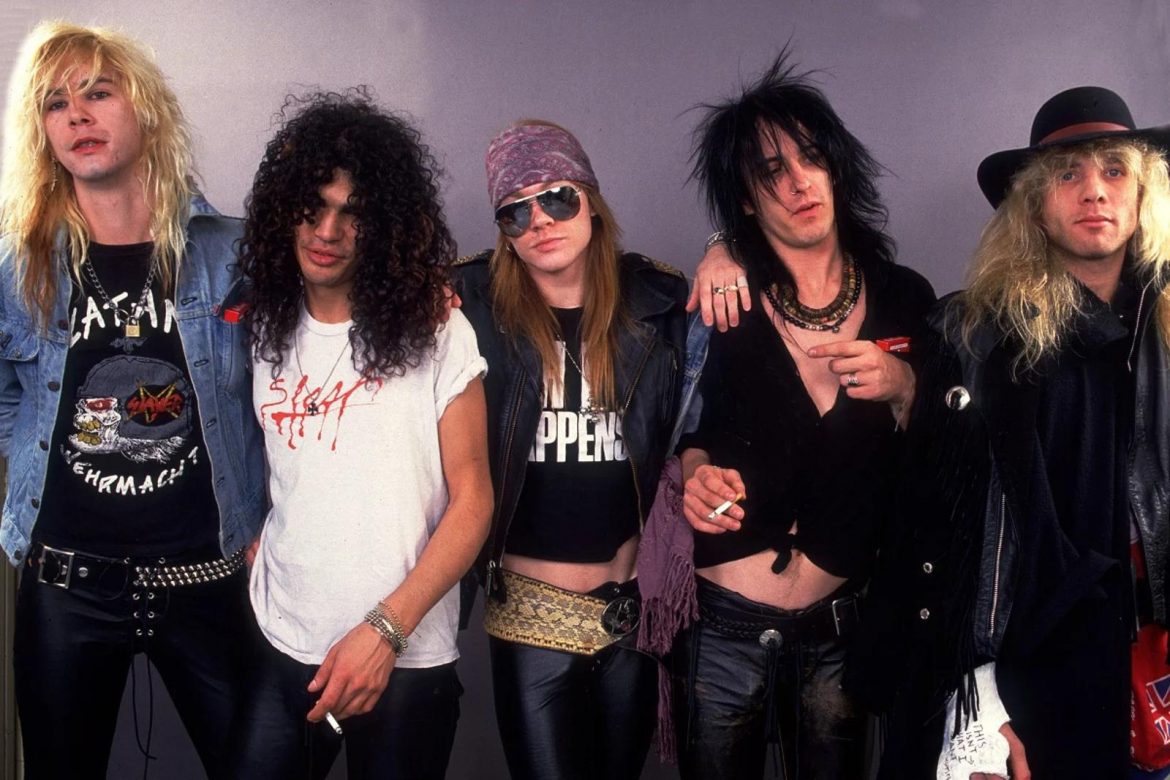The Guns N’ Roses brand is synonymous with excess. The riffs. The rifts. The drugs. The girls. The private jets and never-ending tours. And the mounds of money its members have racked up – and burnt through – in the past 35 years.
Among the most decadent and debauched of rock groups, GNR oozed swagger, danger and machismo from the get-go, launched from the icky asphalt of LA’s Sunset Strip to the world. Celebrating its 35th anniversary this year, genre-defining debut Appetite for Destruction shifted 30 million records – the second-best-selling debut album ever – and spawned five singles, including “Sweet Child o’ Mine”, an earworm so enduring it ensured none of the five founding members would ever have to work again. Well, if they saved, anyway.
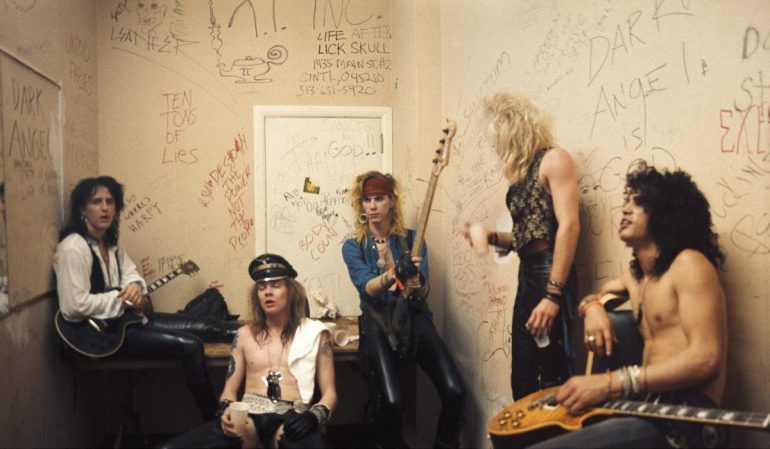
But work they did, maintaining a hectic half-decade heyday schedule that was only matched by the band’s notorious alcohol and substance intake. By 1991, they had shed two members. The same year they simultaneously released two double albums – Use Your Illusion I and II – and embarked on a gruelling two-and-a-half-year tour that would prove the end of the band, in a sense.

So where are they today?
After years of infighting and inactivity, erratic lead singer Axl Rose claimed the blockbuster GNR brand as his own, leading a band of hired hands throughout the early 2000s while top hat-totin’ guitarist Slash and the rest of the OG gang went off to pursue solo careers of varying critical and commercial success.
Until, suddenly in 2016, three of the founding members formed an apparently uneasy, but incredibly lucrative, truce. The subsequent three-year-and-a-half-year Not in This Lifetime … Tour banked an eye-watering US$580 million after playing 158 shows to some 5.3 million people (including this writer, twice) – the equivalent of a cool US$3.7 million per night, making it the third highest-grossing tour in music history. And the juggernaut rolls on, with the post-pandemic We’re F’N Back! Tour trundling on into 2023 – all despite the fact just two new songs have emerged from the band in … 14 years.
At this point, around 80 musicians can claim to have played a role in the muddy GNR story, with 20-plus “official” members on the payroll – but to fans, only those that played on the classic records are truly deserving. So amid this patchwork of feuds, back-stabbing and disputed million-dollar contracts, who banked smart, who got cut out of the picture, and who made off with all the dough?
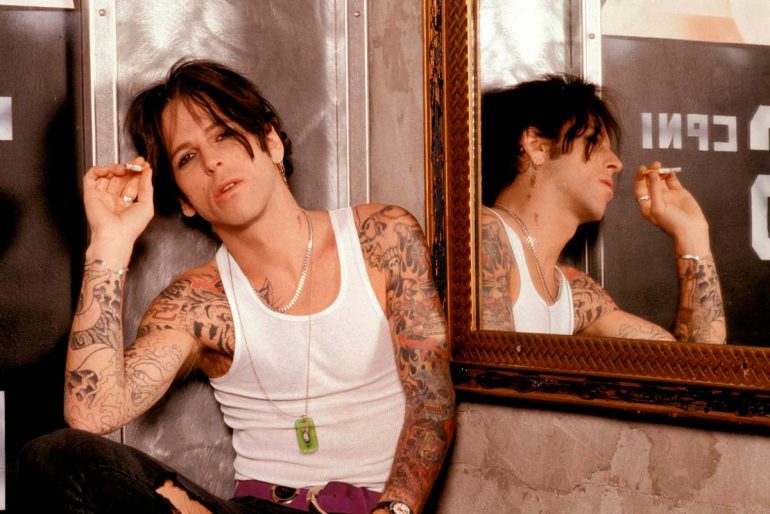
12. Tracii Guns (1985-1985) – US$500,000
Fun fact: before Guns N’ Roses, there were two bands – the Axl Rose-founded Hollywood Rose and guitarist Tracii Guns’ L.A. Guns – which temporarily merged in March 1985. After just three months, Guns fled back to reform his own group, while Rose hired Slash, kept the name … and the rest is history. Perhaps thanks to this fortuitous footnote in rock history, L.A. Guns are still going to this day, with some 19 studio albums to its name, and the 56-year-old founder sitting on a tidy US$500,000 fortune, according to stat-meisters at Celebrity Net Worth (the ever-reliable source of all our noble guesstimates).
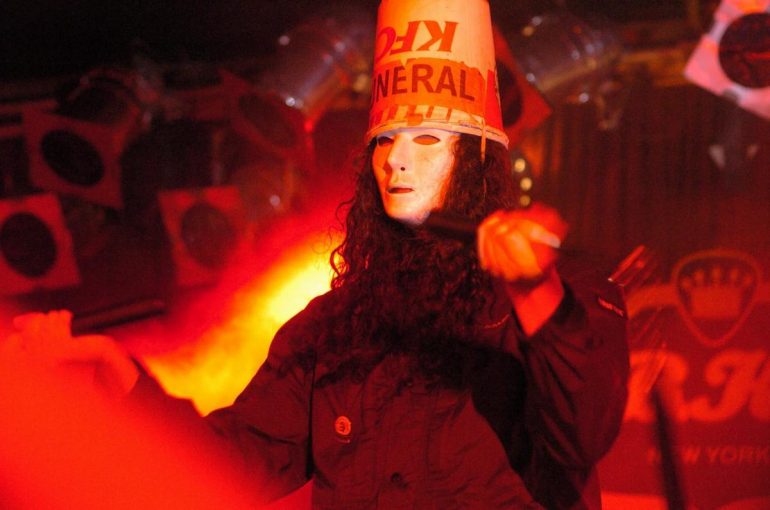
11. Buckethead (2000-2004) – US$4 million
You can only imagine the fan furore when it was announced that Slash, one of the most iconic lead guitarists in history, was being replaced by a man who wore a KFC bucket on his head. But that was the buzz when Rose reassembled a motley band of rock vets and session pros to debut his vision of Guns N’ Roses at Brazil’s Rock in Rio festival in 2001 (there were even rumours it was Slash in disguise).
A virtuoso ranked as one of Guitar World’s “25 all-time weirdest guitarists”, Buckethead’s trademark shredding would feature on Rose opus Chinese Democracy (2008) – the band’s only album of originals in three decades – despite the fact he quit acrimoniously in 2004, reportedly after a band dispute involving … literal dog faeces. The 53-year-old went on to release more than 300 (!) solo albums, largely as part of his Buckethead Pikes series. Yikes.
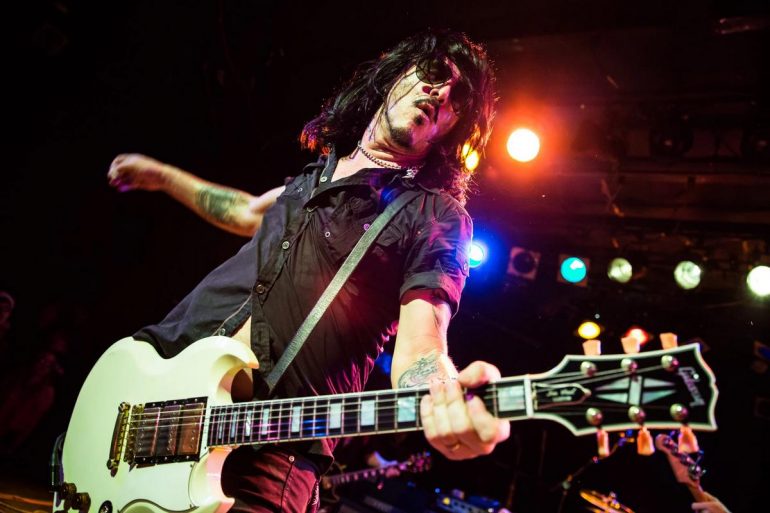
10. Gilby Clarke (1991-1994) – US$5 million
When founding guitarist Izzy Stradlin infamously quit the band midway through the 30-month Use Your Illusion Tour, the unknown Gilby Clarke was tasked with learning the band’s three-hour set in just three weeks. The sudden exposure catapulted him to minor rock fame, paving the way for the first of five solo albums, Pawnshop Guitars, in 1994.
However, Clarke, 60, was clearly never considered more than a hired hand: when whatever was left of the original line-up assembled to record what would be its swansong – a lukewarm cover of The Rolling Stones’ “Sympathy for the Devil” for the Interview with the Vampire soundtrack – Clarke didn’t get the call. Instead he went on to play with members of Metallica and Mötley Crüe in Rock Star Supernova, as well as backing MC5, Heart, Nancy Sinatra and his former bandmate in Slash’s Snakepit.
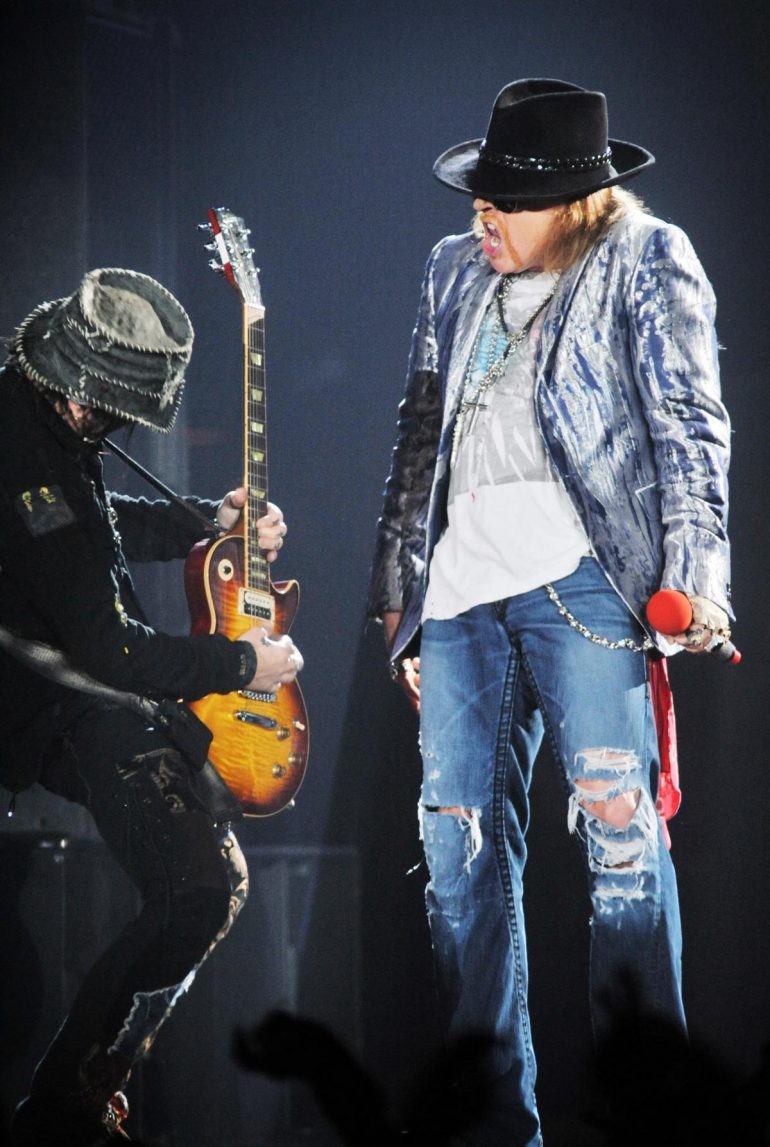
9. DJ Ashba (2009-2015) – US$10 million
Boy, GNR has got through a lot of guitarists – 10 by our maths, not even counting session musicians – but few have made bank as convincingly as DJ Ashba, a man you’d trust anywhere but near your turntable. Known for wearing a top hat and playing note-perfect renditions of all the band’s famous solos on a shiny Gibson Les Paul, Ashba was essentially employed onstage as a dime-store Slash. Of course, he was dumped the minute the main man returned.
Earlier, the 50-year-old enjoyed minor muso fame as a member of BulletBoys and Beautiful Creatures, and formed the band Sixx: A. M with Mötley Crüe bassist Nikki Sixx – a second project which has evidently kept him in demand, and in the cash.
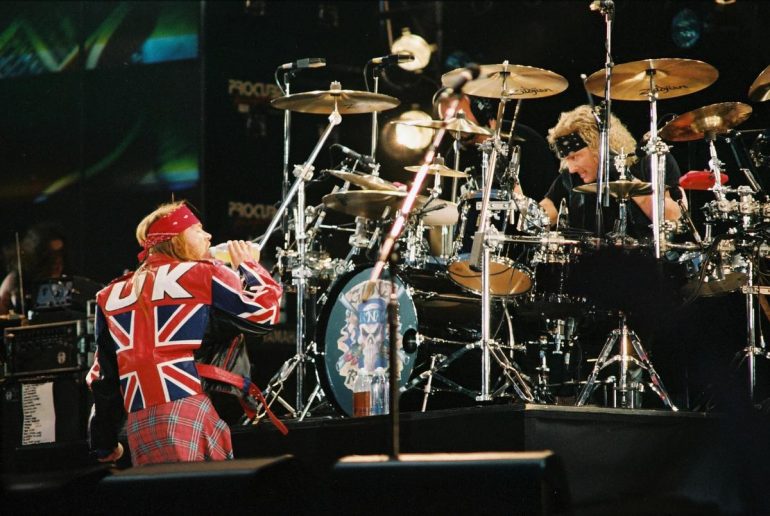
8. Matt Sorum (1990-1997) – US$10 million
When boozy OG sticksman Steven Adler was unceremoniously given the boot, the band called on the proven prowess of The Cult’s touring drummer. Matt Sorum brought a heavier edge to the sprawling Illusion sets’ 30 songs and 194-date tour. However, Sorum was reportedly given his marching orders in 1997 after telling Rose that “without Slash there is no Guns N’ Roses”.
Staying loyal to the horse he’d picked, Sorum would later join Slash, McKagan and Stone Temple Pilots singer Scott Weiland in the supergroup Velvet Revolver, whose debut album Contraband (2004) shifted some 4 million copies amid the dying days of the CD era. After VR imploded in 2008, Sorum went on to back Motörhead and briefly join the Hollywood Vampires – a supergroup featuring Alice Cooper, Johnny Depp and Aerosmith’s Joe Perry.
However, when the big 2016 reunion happened, he read about it on the internet – and was passed over for Frank Ferrer, who has held the chair loyally since 2006. “I can’t say that when it went down, I was completely happy with the circumstances,” he told Rolling Stone in 2021. Thankfully the 62-year-old invested his savings wisely, with investments in six start-ups and a seat on UCLA’s Global Blockchain Business Council.
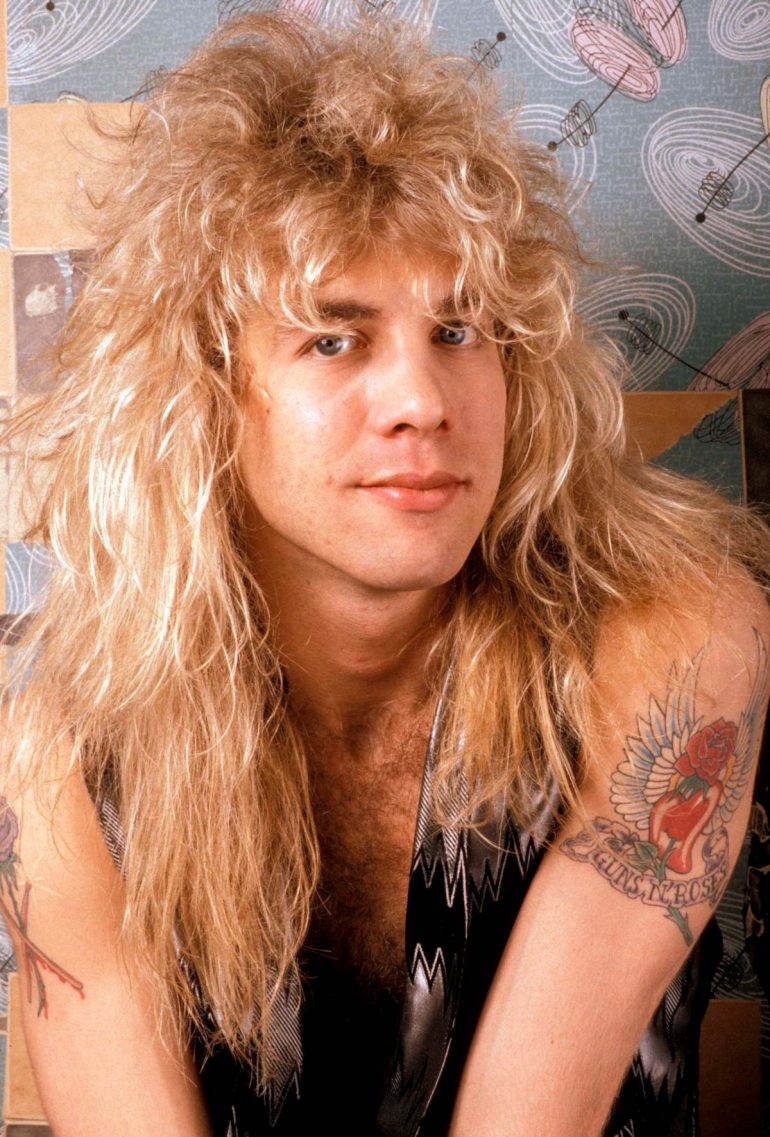
7. Steven Adler (1985-1990) – US$15 million
A notably looser presence and personality than Sorum, Steven Adler lived in the band’s shared “hell house” through their early hustling and penniless drinking bouts. However, when success came knocking, the drummer was increasingly not there to answer the door. In 1987, he missed a string of dates supporting Alice Cooper after breaking his hand in a barroom brawl, according to People. Eventually, after proving unable to record the song “Civil War” in 30-odd takes, he was fired in 1990.
Adler sued the band, and the case was settled out of court in 1993 – to the tune of US$2.25 million in back payments and 15 per cent on all recordings he played on. This, crucially, included bestselling debut Appetite, and the cheques have kept rolling in ever since.
Despite ongoing personal problems, Adler keeps his US$15 million net worth topped up with tribute band Adler’s Appetite, autobiography My Appetite for Destruction: Sex, and Drugs, and Guns N’ Roses, and appearances on Celebrity Rehab with Dr. Drew. In 2016, the hatchet was finally buried when the 57-year-old appeared onstage as a two-song guest with the reformed GNR.

6. Tommy Stinson (1998-2014) – US$20 million
Playing a central role in the group for 16 years, sober-headed Stinson was once described by guitarist Richard Fortus as the interim band’s “ultimate musical director”. We can chalk that up to experience – the 56-year-old made his mark as one quarter of era-defining alternative act The Replacements, whose string of 80s heyday albums are heralded as punk-rock classics. While that band doesn’t enjoy the same household recognition as his other big employer, they reformed in 2012 for a no-doubt lucrative reunion tour – which will have topped up whatever Stinson earned from being one of only two men to play bass in Guns N’ Roses.
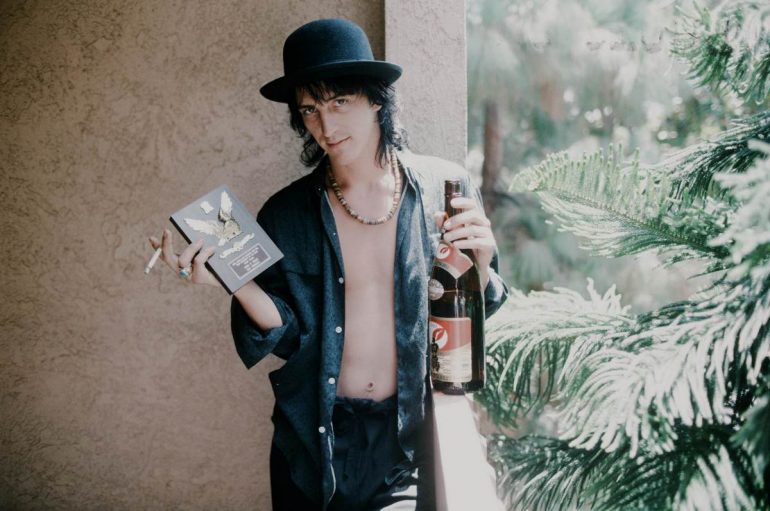
5. Izzy Stradlin (1985-1991) – US$28 million
If Slash brought the rock, then Izzy was the roll – no player in the knotty GNR genealogy is as missed, or as misunderstood, as Izzy Stradlin. The man known as Jeffrey Dean Isbell to his mum was a founding member of Hollywood Rose back in 1983, where early GNR songs first surfaced, and is credited with writing most the band’s early musical material. The only problem? He wasn’t a huge fan of fame.
Following an incident that saw him earn the nickname “Whizzy” when he lost his, ahem, patience on an aeroplane in 1989, Stradlin gave up drugs and booze, and became increasingly estranged from his hard-living bandmates. He began skipping the collective carnage of the band’s private plane and instead driving between shows in his own van. That arrangement naturally didn’t last forever.
Never forgiven for his abrupt 1991 departure, Stradlin went on to follow his own laid-back muse with a run of rootsy, Stonesy solo albums – which sound great (117° is STYLE’s pick) but are unlikely made him much cash (contrast his 18,000 monthly Spotify listeners with GNR’s 24 million) – and even turned down the chance to rejoin his former bandmates in Velvet Revolver after suggesting they skip stadiums and instead “just do a club tour in a van”.
The 60-year-old was also reportedly invited to the 2016 GNR reunion tour, but walked away because the other members “didn’t want to split the dough equally”, he said in a since-deleted 2019 tweet, instead leaving long-serving Fortus (net worth: US$10 million) to play rhythm guitar, a position he’s held since 2002.
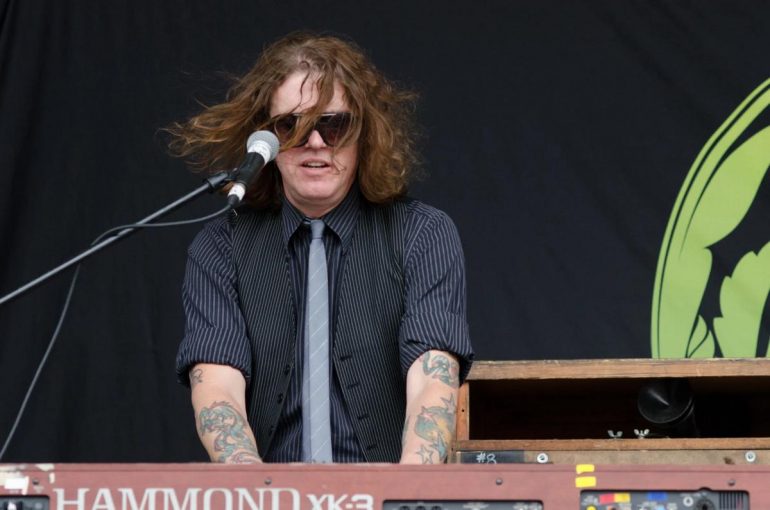
4. Dizzy Reed (1990-present) – US$40 million
Many fans might find it a travesty that the band’s session keyboardist has earned more than the guy who wrote all the classic songs. But as the band’s longest-serving instrumentalist, the 59-year-old Dizzy Reed has clearly played the long game. Initially brought in as a hired hand on the Illusion albums, his synth work lent drama to live renditions of epics “November Rain” and “Estranged” … And then he simply never left.
When the rest of the classic line-up disintegrated in the late 90s, Reed stayed loyally by Rose’s side. And so when Slash and McKagan rejoined, he became the only familiar face amid the Rose-era backline of Fortus n’ Ferrer that remained. After 33 uninterrupted years in the same band, he’s not had much time to make his own mark, but has dabbled in film scores, played in supergroup The Dead Daisies and leads his own covers band, Hookers N’ Blow.
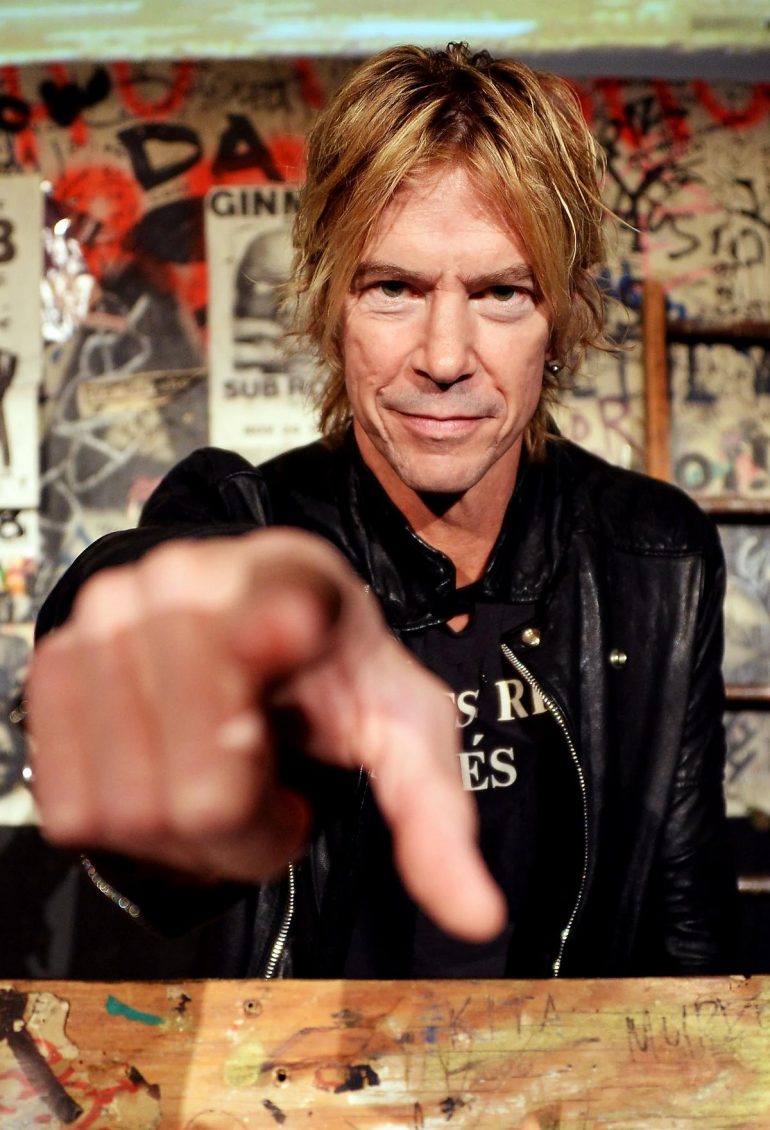
3. Duff McKagan (1985-1997, 2016-present) – US$70 million
Here’s an instructive tale: when Guns N’ Roses started to wind down, in 1994, Duff McKagan enrolled in a basic finance course. A few months earlier, he’d suffered a life-threatening pancreatic burst that forced him to quit drinking, aged 30. Newly sober, the bassist found himself thumbing through the messy GNR accounts – and realised he had no idea where his money was going. Later, in 2009, he started writing a financial management column, titled “Duffonomics” (for Playboy, mind). So it’s safe to say McKagan’s rock star riches are well accounted for – and well-earned.
For the record: 58-year-old McKagan was the third to join, in March 1985, three months before Slash and Adler. Schooled on Seattle punk, he brought an unstudied edge and anti-authoritarian slant to the band’s early classic rock style, and was the final founding father to hand in his notice in August 1997.
But he did anything but rest, playing a key role in at least six post-Guns projects – forming the Neurotic Outsiders supergroup with Sex Pistols’ Steve Jones and Duran Duran’s John Taylor, leading his own group Loaded and, of course, joining Velvet Revolver. Duff also played briefly with blockbuster bands Jane’s Addiction and Alice in Chains (as a guitarist!), and reformed his pre-GNR hardcore 10 Minute Warning outfit.
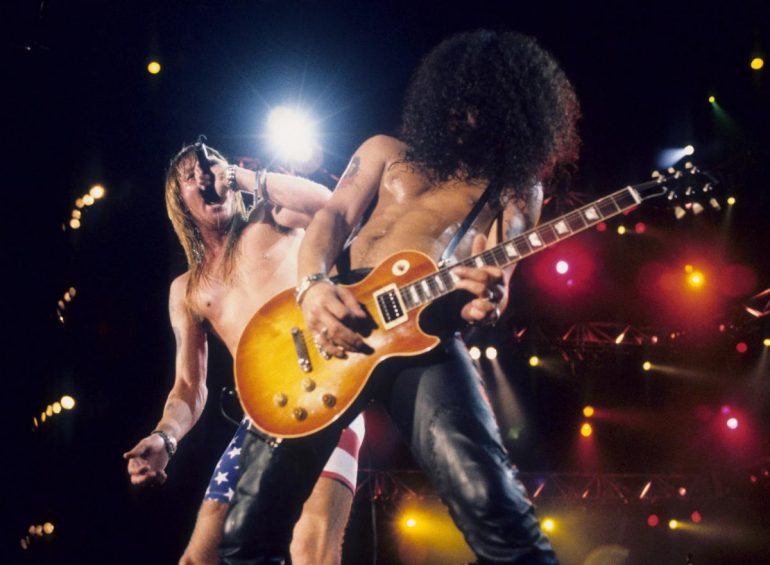
2. Slash (1985-1996, 2016-present) – US$90 million
We’ll never know how many zeroes were on the fabled contract that Slash signed in 2016 – the same deal that history suggests cut out Adler/Sorum and lowballed Stradlin – but it surely goes a long way to explaining how much more he and McKagan have earned than his OG GNR counterparts. The other explanation for the duo’s superior wealth? Their phenomenal work rate.
Despite a relatively modest songwriting contribution, Slash’s unmistakable guitar work is the stuff of legend. He spewed out searing, spontaneous solos that are still hummed note for note by entire stadiums. And is there a more easily recognisable guitarist on the planet?
When his demos for a sixth GNR album were rejected by Rose, the man born Saul Hudson called sidemen Clarke, Reed and Sorum to record them as Slash’s Snakepit, resulting in the strong debut It’s Five O’Clock Somewhere (1995). After making bank with Velvet Revolver, he formed backing band The Conspirators, fronted by vocalist Myles Kennedy – a singer who does such a good Rose impression he stood in during Guns N’ Roses’ 2012 induction to the Rock & Roll Hall of Fame.
Other revenue streams include an obligatory tell-all rock star memoir (Slash, 2007), helping design a GNR pinball machine, licensing his likeness to the Guitar Hero video game franchise and a new 364-page coffee table book detailing his extensive Gibson guitar collection, Slash: The Collection – priced at US$249 or US$999. And how does the 57-year-old spend it all? “Snakes, guitars and cars,” he told Guitar Player back in 1991. “I try not to spend too much on women.”
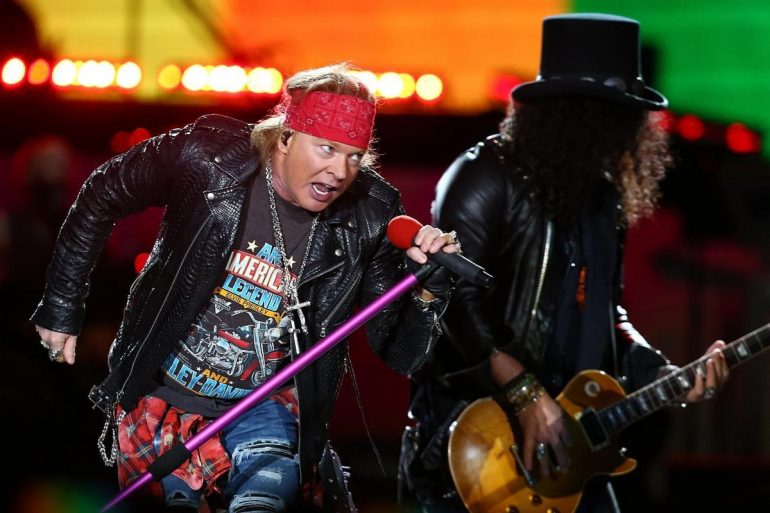
1. Axl Rose (1985-present) – US$200 million
As the only consistent member over the band’s 37-year history – and the legal owner of the brand – it’s perhaps no surprise that lead singer Axl Rose made more than double his other band members. Rose banked money not just from the group’s 87-93 heyday, or the current post-2016 reunion, but also the 13-year run between 2001 and 2014 when he essentially toured as a solo artist under the GNR banner – for more than 350 blockbuster gigs. In that time he also released the band’s sixth, and at present final, album – Chinese Democracy, a labour of hate that took more than a decade to record at a cost of US$13 million.
How did this extraordinary kinglike reign come to be? Rose may be renowned for his eccentric behaviour and controlling tendencies. But he was also widely assumed to be the most sober one at the party. According to Slash’s autobiography, as communication broke down, Rose took the bizarre step of legally quitting the band in 1995 – so that he could buy the business outright. “I was blindsided by it, more or less a legal faux pas,” Slash told MTV at the time. “But I’d be lying to say I wasn’t a little bit peeved.”
And with that, it appears Rose, now 60, could do whatever he wanted with the name – including, presumably, re-employing his former bandmates more than 20 years later at whatever rate he felt like. And that’s how you get the biggest cut of the pie, folks.
Note: This story was originally published on SCMP and has been republished on this website.
